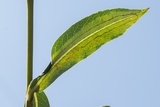Phyllocnistis saligna (Zeller, 1839) Species
Last modified: Dec. 14, 2024, 4:53 p.m.
A rather common species in Belgium. Earlier, it was only known from BR, but since 2012 the species seems to have spread all over the country, and sometimes the mines are really common.
Details
- Classification
- Family: Gracillariidae > Subfamily: Phyllocnistinae > Genus: Phyllocnistis > Species: Phyllocnistis saligna
- Vernacular names
- Wilgenslakkenspoormot (NL), Willow bent-wing (EN), Weiden-Schneckenmotte (DE)
- First mention in Belgium
- Fologne E. 1859b. Supplément au catalogue des lépidoptères de Belgique. — Annales de la Société entomologique belge 3: 133–142. On page 140 (as Phyllocnistis saligna. Zell.). view page
- Status
-
Native
Distribution
Imago
Head white; forewing ground colour white, a white basal streak edged at both sides with dark brown scales; the inner space between these lines can be filled with light or dark brown scales; four costal streaks of which the second is prolonged till the dorsum; dorsal half of apical area ochreous; a conspicuous black spot in the apical area from which two hooks depart into the cilia forming a horizontal "V", plus an inconspicuous third hook pointing downwards.
Caterpillar
Whitish green.
Mine
A long, narrow winding, translucent corridor on either side of a leaf. Most of the time, young leaves at the end of a branch are preferred. The caterpillar can move to different leaves via the leaf stem. Frass in a sometimes inconspicuous, and often interrupted central line.
See also gracillariidae.net and bladmineerders.be.
Cocoon/pupa
Not a real cocoon, but a flimsy spinning.
Bionomics
The eggs are oviposited on either side of a leaf.
Pupation in a flimsy membrane at the end of the mine under a fold of the leaf margin.
The adults are active at dusk. The species hibernate in the adult stage, the adults hide in thatch or hayricks.
Flight periods
The adults fly in two generations a year in July and again from August till April of the next year.
Observed on
- Host plant (species):
- Salix fragilis and Salix alba
- Host plant (genera):
- Salix and Populus
The species lives mainly on Salix alba, but it has been recorded from several other Salix species with narrow leaves.


